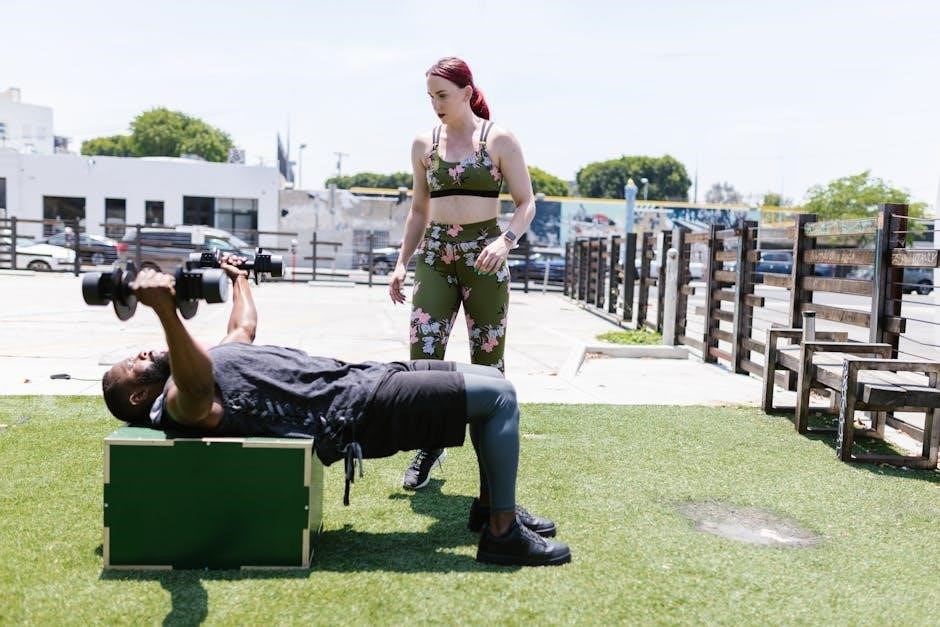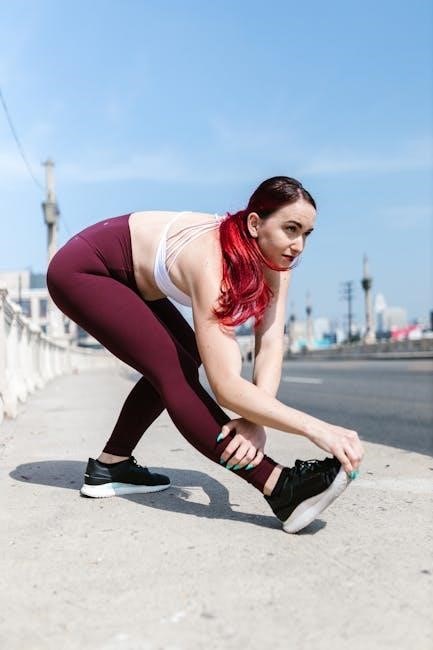Bodyweight workouts are incredibly accessible, requiring no equipment and fitting seamlessly into busy schedules.
These routines, often under 30 minutes,
offer a fantastic way to build strength and improve fitness,
anytime and anywhere – even with just 20 minutes available!
Full-body workouts maximize efficiency, proving you don’t need a gym or extensive time commitment to see results.
These routines, led by fitness experts,
are designed to build functional strength and get your heart rate up.
What are Bodyweight Workouts?
Bodyweight workouts utilize your own weight as resistance, eliminating the need for dumbbells, machines, or any external equipment. This makes them exceptionally versatile and convenient, allowing you to exercise virtually anywhere – your living room, a park, or even a hotel room.
These workouts encompass a wide range of exercises, including push-ups, squats, lunges, planks, and various core exercises. They are fundamentally about leveraging gravity and your body’s mass to challenge your muscles and improve overall fitness.
The beauty of bodyweight training lies in its scalability; exercises can be modified to suit different fitness levels. Beginners can start with easier variations, while more advanced individuals can increase the difficulty through progressions or by adding repetitions. As highlighted, even a short 20-30 minute session can deliver significant benefits, building functional strength and boosting cardiovascular health.
Benefits of Bodyweight Training
Bodyweight training offers a plethora of advantages, making it an ideal fitness solution. Firstly, it’s incredibly accessible – no gym membership or expensive equipment is required. This lowers the barrier to entry and promotes consistency. Secondly, it enhances functional strength, improving everyday movements like lifting, bending, and walking.
Furthermore, bodyweight exercises improve muscular endurance, core stability, and flexibility. They also contribute to better posture and balance. A key benefit is the ability to tailor workouts to individual fitness levels, ensuring progressive overload and continuous improvement.
Even short, 30-minute routines, as demonstrated by fitness professionals, can significantly boost cardiovascular health and burn calories. These workouts are time-efficient, making them perfect for busy lifestyles, proving anyone can get fitter and stronger using just their bodyweight.
Why a 30-Minute Duration?
A 30-minute workout strikes an optimal balance between effectiveness and feasibility. It’s long enough to deliver significant fitness benefits – building strength, improving cardiovascular health, and boosting endurance – without demanding an excessive time commitment. This duration aligns perfectly with busy schedules, making consistent exercise more attainable.
Short, focused workouts, even just 20 minutes, can be incredibly impactful, as highlighted by various fitness challenges and programs; They encourage adherence, as the time investment feels less daunting. Moreover, 30 minutes allows for a comprehensive routine including a warm-up, workout, and cool-down.
Experts demonstrate that these routines, often circuit-based, maximize calorie burn and muscle engagement within a limited timeframe, proving that quality trumps quantity when it comes to fitness.

Warm-up (5 Minutes)
A proper warm-up is crucial, preparing muscles for exertion and preventing injury. Focus on dynamic stretching and cardio activation to increase blood flow and flexibility.
Dynamic Stretching
Dynamic stretching involves controlled movements that take your joints through their full range of motion. This is far superior to static stretching before a workout, as it actively prepares your muscles for activity.
Include exercises like arm circles, leg swings (forward, backward, and sideways), torso twists, and high knees. These movements increase blood flow, improve flexibility, and enhance muscle activation.
Spend approximately 2-3 minutes performing these stretches, focusing on controlled movements rather than bouncing. For example, perform 10-15 repetitions of each stretch. Prioritize movements that target the muscle groups you’ll be using during your workout, ensuring a comprehensive warm-up.
Remember, the goal is to gently prepare your body, not to push your limits during the warm-up phase.
Cardio Activation
Cardio activation is crucial for elevating your heart rate and preparing your cardiovascular system for the intensity of the workout. This phase should seamlessly follow dynamic stretching, building upon the increased blood flow.
Incorporate light cardio exercises like jumping jacks, high knees, butt kicks, or brisk marching in place. Aim for approximately 2-3 minutes of continuous movement. Focus on maintaining a moderate intensity – you should be slightly breathless but still able to hold a conversation.
Consider incorporating walking-based workouts, as these are effective for clocking steps and raising your heart rate. This activation phase primes your body for optimal performance and reduces the risk of injury during the more strenuous exercises to come.

Workout Structure (20 Minutes)
Circuit training is ideal for maximizing efficiency within a 30-minute timeframe, offering a full-body challenge.
Alternate exercises with minimal rest,
completing multiple rounds to build strength and endurance.
Circuit Training Approach
Circuit training is a highly effective method for structuring your 20-minute workout, maximizing calorie burn and muscle engagement in a limited timeframe. This approach involves performing a series of exercises – typically 5-8 – one after the other with minimal rest in between.
Once you’ve completed all exercises in the circuit, you take a slightly longer rest period before repeating the entire sequence. This cycle of exercises and rest is what defines a circuit. It’s a fantastic way to combine strength and cardio, keeping your heart rate elevated throughout the workout.
The beauty of circuit training lies in its adaptability; you can easily modify exercises to suit your fitness level and target specific muscle groups. It’s a cornerstone of efficient bodyweight training, delivering a full-body workout in just minutes!
Exercises per Circuit
Each circuit should ideally contain 5-8 exercises targeting different muscle groups to ensure a balanced, full-body workout. Consider incorporating movements like squats, push-ups, lunges, and planks – foundational bodyweight exercises that require no equipment.
Variety is key! Include exercises that challenge your upper body, lower body, and core. For example, a circuit might consist of squats, push-ups, walking lunges, plank, tricep dips (using a chair), and Russian twists.
Remember to prioritize proper form over speed. A well-executed exercise with controlled movements is far more effective than rushing through repetitions with poor technique. This approach maximizes results and minimizes the risk of injury during your 30-minute routine.
Rounds and Rest Periods
For a 20-minute workout segment, aim for 3-4 rounds of your chosen circuit. This allows sufficient time to challenge your muscles without overexertion. Adjust the number of rounds based on your fitness level – beginners might start with 3, while more experienced individuals can aim for 4 or even 5.
Rest periods are crucial for recovery and maintaining good form. After completing one circuit, allow for 60-90 seconds of rest before starting the next round. Between exercises within a circuit, keep rest periods short – around 15-30 seconds – to maintain intensity.
Listen to your body and adjust rest times as needed. Prioritize quality over quantity; adequate rest ensures you can perform each exercise effectively and safely throughout your 30-minute session.

Core Exercises (5 Minutes)
Strengthen your core with plank variations, crunches, leg raises, and Russian twists. These exercises build functional strength,
improving stability and overall fitness in just five minutes!
Plank Variations
Planks are foundational for core strength, and variations increase the challenge. Begin with a standard plank, maintaining a straight line from head to heels, engaging your core. Hold for 30-60 seconds, focusing on proper form.
Next, introduce side planks, targeting obliques. Lie on your side, propped up on your forearm, and lift your hips off the ground. Repeat on both sides. For an added challenge, try plank jacks – jumping your feet in and out while maintaining the plank position.
Forearm planks are another excellent option, reducing stress on the wrists. Finally, consider mountain climbers, bringing your knees towards your chest in a running motion while in a plank position; These variations build endurance and functional strength, crucial for a well-rounded workout.
Crunches and Leg Raises
Crunches are a classic core exercise, but focus on quality over quantity. Lie on your back with knees bent and feet flat, then lift your shoulders off the ground, engaging your abdominal muscles. Avoid pulling on your neck.
Leg raises target the lower abs. Lie flat and lift your legs towards the ceiling, keeping them straight or slightly bent. Control the movement and avoid arching your back. Combine these with reverse crunches, bringing your knees towards your chest while lifting your hips slightly off the ground.
These exercises, when performed correctly, build core strength and stability. Remember to breathe consistently throughout each movement and maintain proper form to maximize effectiveness and prevent injury.
Russian Twists
Russian twists are excellent for targeting your obliques and rotational core strength. Sit on the floor with your knees bent and feet slightly elevated (or flat for beginners). Lean back slightly, maintaining a straight spine.
Twist your torso from side to side, touching your hands (or a light weight, if desired) to the floor beside you. Focus on controlled movements and engaging your core throughout the exercise.
To increase the challenge, extend your arms further or lift your feet higher. Remember to breathe deeply and maintain good posture. This exercise complements crunches and leg raises, creating a well-rounded core routine for a stronger, more stable body.

Upper Body Exercises (5 Minutes)
Focus on building upper body strength with variations of push-ups and tricep dips, utilizing a chair for support.
These exercises build functional strength quickly!
Push-up Variations
Push-ups are a cornerstone of any effective bodyweight upper body routine, offering scalability for all fitness levels. Begin with standard push-ups, focusing on proper form – a straight line from head to heels. To increase difficulty, try incline push-ups, elevating your feet on a stable surface.
Conversely, knee push-ups provide a modified version for beginners, reducing the load. For an added challenge, incorporate diamond push-ups, bringing your hands together under your chest to target the triceps more intensely.
Experiment with wide-grip push-ups to emphasize the chest muscles, and close-grip push-ups to focus on the triceps. Remember to maintain controlled movements throughout each variation, prioritizing quality over quantity. These variations build functional strength and are a fantastic workout!
Incline Push-ups
Incline push-ups are a fantastic modification and progression within a bodyweight workout, offering a unique challenge to standard push-ups. By elevating your hands on a stable surface – a bench, chair, or sturdy box – you shift the emphasis to the lower chest and shoulders.
This variation is excellent for beginners building upper body strength, as it reduces the overall load compared to floor push-ups. It also allows for a greater range of motion, potentially improving muscle activation.
Focus on maintaining a straight line from head to heels, engaging your core throughout the movement. Controlled descent and explosive ascent are key. Incline push-ups build functional strength and are a great way to fire up your upper body!
Tricep Dips (using a chair)
Tricep dips, utilizing a sturdy chair, are a highly effective bodyweight exercise targeting the back of your arms – the triceps. Position your hands shoulder-width apart on the chair’s edge, fingers pointing forward. Extend your legs out in front of you, keeping a slight bend in your knees.
Lower your body by bending your elbows, keeping your back close to the chair. Descend until your upper arms are parallel to the floor, then powerfully push back up to the starting position.
Engage your core to maintain stability and avoid swinging. This exercise builds functional strength and is a fantastic addition to any upper body routine, helping to sculpt and tone your arms.

Lower Body Exercises (5 Minutes)
Strengthen your legs with variations of squats and lunges, plus calf raises. These exercises build lower body strength,
enhancing functional fitness and overall stability.
Squat Variations
Squats are foundational for lower body strength, and variations keep the workout engaging and challenging. Begin with basic squats, focusing on proper form – chest up, back straight, and weight in your heels. Next, incorporate jump squats to elevate your heart rate and build explosive power.
For an added challenge, try pulse squats, holding the squat position and performing small, controlled pulses. Bulgarian split squats, using a chair for elevation, target each leg individually, improving balance and stability. Remember to maintain control throughout each movement, prioritizing form over speed. These variations effectively target quads, hamstrings, and glutes, contributing to a well-rounded lower body workout within your 30-minute routine.
Lunges
Lunges are excellent for building lower body strength, improving balance, and enhancing coordination. Start with forward lunges, ensuring your front knee doesn’t extend past your toes and your back knee gently lowers towards the ground. Add reverse lunges to target different muscle groups and challenge stability.

For increased intensity, incorporate walking lunges, continuously stepping forward into each lunge. Lateral lunges work the inner and outer thighs, promoting functional strength. Remember to keep your core engaged and maintain a controlled descent and ascent. These variations effectively work quads, glutes, and hamstrings, fitting seamlessly into a time-effective, 30-minute bodyweight workout, building functional strength.
Calf Raises
Calf raises are a simple yet effective exercise for strengthening the calf muscles – gastrocnemius and soleus; Begin by standing with your feet flat on the floor, then slowly rise up onto your toes, squeezing your calves at the top of the movement. Lower back down with control.
To increase the challenge, perform single-leg calf raises, focusing on balance and stability. You can also do them on an elevated surface, like a step, for a greater range of motion. Incorporating calf raises into your 30-minute bodyweight routine builds lower leg strength, improving athletic performance and everyday functionality. They are a fantastic addition to any fitness regimen, requiring no equipment.

Cool-down (5 Minutes)
Cooling down is crucial for recovery, involving static stretching to improve flexibility and breathing exercises to lower your heart rate post-workout.
Static Stretching
Static stretching involves holding a stretch for a sustained period, typically 20-30 seconds, to increase flexibility and range of motion. This phase is vital after a bodyweight workout to help muscles recover and reduce the risk of soreness.
Focus on major muscle groups worked during the session. Examples include holding a hamstring stretch by reaching for your toes, a quadriceps stretch by pulling your heel towards your glutes, and a triceps stretch by reaching one arm overhead and bending at the elbow.
Remember to breathe deeply and avoid bouncing, as this can cause injury. Static stretching promotes relaxation and helps your body transition back to a resting state, completing the workout effectively.
Prioritizing this cool-down component is essential for long-term fitness and injury prevention.
Breathing Exercises
Breathing exercises are a crucial, often overlooked, component of a well-rounded 30-minute bodyweight workout. They help regulate your nervous system, promoting relaxation and aiding recovery after exertion. Deep, controlled breathing can lower your heart rate and reduce stress levels.
Simple techniques include diaphragmatic breathing – inhaling deeply into your abdomen, allowing it to expand – and box breathing, where you inhale for four counts, hold for four, exhale for four, and hold again for four.
These exercises enhance oxygen delivery to muscles, supporting recovery and reducing muscle soreness. Incorporating mindful breathing into your cool-down routine maximizes the benefits of your workout, leaving you feeling refreshed and revitalized.
Focus on slow, deliberate breaths for optimal results.

Creating Your Own 30-Minute Bodyweight Workout PDF
Personalize your fitness! Design a 30-minute bodyweight workout PDF, tracking progress and customizing exercises to fit your needs and fitness level effectively.
Workout Customization
Tailoring your 30-minute bodyweight workout PDF is key to sustained progress and enjoyment. Consider your current fitness level – beginners should start with fewer repetitions and simpler variations of exercises.
Don’t hesitate to modify exercises! If standard push-ups are too challenging, opt for incline push-ups. Adjust the number of rounds and rest periods based on your endurance.
Variety is crucial. Swap exercises regularly to prevent plateaus and keep things interesting. Focus on hitting all major muscle groups within your 30-minute timeframe.
Remember, a successful PDF workout reflects your body and goals. Prioritize functional strength and listen to your body, adjusting as needed for optimal results and injury prevention.
Tracking Progress
Monitoring your advancement within your 30-minute bodyweight workout PDF is vital for motivation and effectiveness. Record the number of repetitions, sets, and variations completed for each exercise during each session.
Note any challenges encountered – were certain exercises particularly difficult? This informs future adjustments. Consider tracking subjective measures like perceived exertion (how hard the workout felt).
Regularly assess your ability to perform exercises with good form. Can you now do standard push-ups when you previously needed incline variations?
Visual progress, like taking photos, can also be incredibly motivating. Consistent tracking provides data to demonstrate your improvements and refine your workout plan over time.
Resources for PDF Creation
Numerous digital tools facilitate creating a professional-looking 30-minute bodyweight workout PDF. Microsoft Word and Google Docs offer basic formatting and export-to-PDF functionality, suitable for simpler workout plans.
For more visually appealing and structured PDFs, consider Canva, a user-friendly graphic design platform with pre-designed templates. Adobe InDesign provides advanced layout control, ideal for complex workout guides.

Online PDF editors like Smallpdf or iLovePDF allow you to merge images, text, and existing documents into a cohesive PDF.
Remember to include clear exercise instructions, images or videos (linked via QR code), and a workout schedule within your PDF for optimal usability.